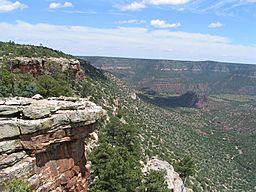High Plains (United States) facts for kids
Quick facts for kids High Plains |
|
| physiographic region | |
|
The High Plains are broken in places by canyons, such as this one in Sabinoso Wilderness in New Mexico.
|
|
| Country | United States |
|---|---|
| Highest point | |
| - elevation | 7,800 ft (2,377 m) |
| Lowest point | |
| - elevation | 1,160 ft (354 m) |
| Length | 800 mi (1,287 km) |
| Width | 400 mi (644 km) |
| Area | 174,000 sq mi (450,658 km²) |
The High Plains are a subregion of the Great Plains. They are the western part of the Great Plains before the region reaches the Rocky Mountains.
The High Plains are in southeastern Wyoming, southwestern South Dakota, western Nebraska, eastern Colorado, western Kansas, eastern New Mexico, western Oklahoma, and south of the Texas Panhandle. They are mostly in the Western United States, but also partly in the Midwest states of Nebraska, Kansas, and South Dakota.
Geologically, the high plains are caused by the same process as caused the Rockies. The cause is the westward movement of North America away from Eurasia, which has been going on for over 100 million years. As the continent moved west, it subducted plates under the western side, and stretched out its eastern side. This explains why the western states all have some mountainous terrain, and the eastern states in the south are so low-lying.
From east to west, the High Plains rise in elevation from around 1,160 feet (350 m) to over 7,800 feet (2,400 m). The High Plains has a "cold semi-arid" climate—Köppen BSk—they get between 10–20 inches (250–510 mm) of precipitation annually.
Due to low moisture and high elevation, the High Plains get extremes of temperature. The temperature range from day to night is usually 30 °F (17 °C), and 24-hour temperature shifts of 100 °F (56 °C) are possible.
In Browning, Montana from January 23, 1916 to January 24, 1916, the temperature fell from 44 to −56 °F (7 to −49 °C). This is the world record for the greatest temperature change in 24 hours. The region is known for the steady, and sometimes intense, winds that come from the west. These add a considerable wind chill factor in the winter. The development of wind farms in the High Plains is one of the latest areas of economic development.
The High Plains has one of the lowest population densities of any region in the continental United States; Wyoming, for example, has the second lowest population density in the country after Alaska.
Images for kids
-
Childress County, Texas, June 1938.
-
Cimarron County near Boise City. (2009)
-
High Plains in Southeastern Colorado (2009)









